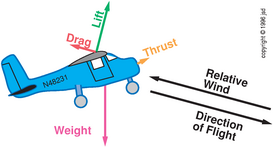LWTD: The Four Forces
LIFT | WEIGHT | THRUST | DRAG It is not necessary for pilots to have a super-precise understanding of the four forces. The concept of energy is considerably more important. In the cockpit (especially in critical situations like final approach) I think about the energy budget a lot, and think about forces hardly at all. Still, there are a few situations that can be usefully discussed in terms of forces, so we might as well learn the terminology.
The relative wind acting on the airplane produces a certain amount of force which is called (unsurprisingly) the total aerodynamic force. This force can be resolved into components, called lift and drag.

Total Aerodynamic Force = Lift + Drag
Here are the official, conventional definitions of the so-called four forces:
- Lift is the component of aerodynamic force perpendicular to the relative wind.
- Drag is the component of aerodynamic force parallel to the relative wind.
- Weight is the force directed downward from the center of mass of the airplane towards the center of the earth. It is proportional to the mass of the airplane times the strength of the gravitational field.
- Thrust is the force produced by the engine. It is directed forward along the axis of the engine.
It is ironic that according to convention, the total aerodynamic force is not listed among the four forces.

The Four Forces — Low Speed Descent

